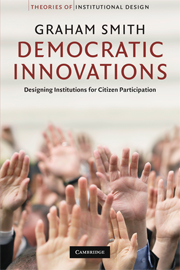Book contents
- Frontmatter
- Contents
- Acknowledgments
- Introduction
- 1 Studying democratic innovations: an analytical framework
- 2 Popular assemblies: from New England town meetings to participatory budgeting
- 3 Mini-publics: assemblies by random selection
- 4 Direct legislation: direct democracy through the ballot box
- 5 E-democracy: the promise of information and communication technology
- 6 Realising the goods of democratic institutions
- Conclusion
- References
- Index
3 - Mini-publics: assemblies by random selection
Published online by Cambridge University Press: 19 January 2010
- Frontmatter
- Contents
- Acknowledgments
- Introduction
- 1 Studying democratic innovations: an analytical framework
- 2 Popular assemblies: from New England town meetings to participatory budgeting
- 3 Mini-publics: assemblies by random selection
- 4 Direct legislation: direct democracy through the ballot box
- 5 E-democracy: the promise of information and communication technology
- 6 Realising the goods of democratic institutions
- Conclusion
- References
- Index
Summary
This chapter turns our attention to democratic innovations that are distinguished by their mode of selecting citizens, namely random selection. Random selection has a long democratic heritage: it was the preferred method for selecting positions of political authority in the Athenian polis and continued to play a part in republican thought and practice throughout the Middle Ages and the Renaissance and into the seventeenth and eighteenth centuries (Manin 1997). Given this democratic heritage it is perhaps surprising that it has played little or no role in contemporary political systems, where selection by competitive elections is generally perceived to be the democratic method of choice for positions of political authority. The most prominent exception to this rule is the randomly selected jury used in a number of legal systems in advanced industrial democracies: ‘an obligation which may in principle fall upon any citizen, is almost the sole vestige of direct citizen participation in law-making and administration which survives in modern democracies’ (Arblaster 1994: 18).
Within the Athenian political system, lot and rotation governed the selection of magistrates, the council and the pool of volunteers for juries – all highly significant positions of political authority. As a selection mechanism, lot and rotation gave full expression to the principle of democratic citizenship by providing the occasion for citizens to rule and be ruled in turn: ‘For Aristotle, this alternation between command and obedience even constituted the virtue or excellence of citizens’ (Manin 1997: 28).
- Type
- Chapter
- Information
- Democratic InnovationsDesigning Institutions for Citizen Participation, pp. 72 - 110Publisher: Cambridge University PressPrint publication year: 2009



